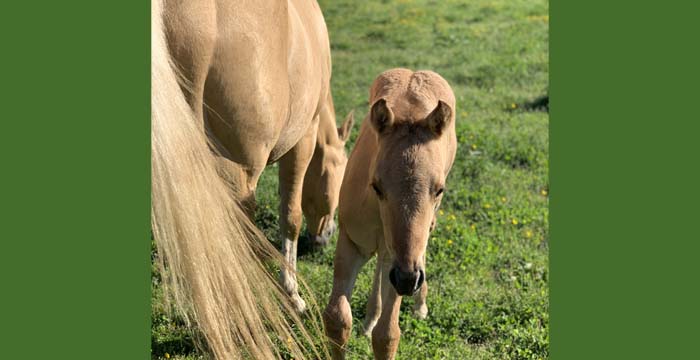Horses have a way of reminding me how quickly things can go awry. Over the years, I’ve started running my mares in small herds with the breeding stallion. Everyone is happier and conception rates are better, but it does come with a few kicks and bites. I’m always more apprehensive turning out mares with foals at their side. I know the mares can stand their ground, but it’s easy for a baby to get caught in the crossfire.
This year, I turned out my first mare and foal with my younger stallion, Hawk. The mare is an experienced herd leader, and they spent all summer together last year. I expected some scuffles while she put him in his place, but as often happens with horses, it all went bad—quickly.
When they met for the first time, it happened to be in the only slick spot in a huge field. As she wheeled and turned to kick at him, she slipped, and landed upside down with two legs through a wire fence, and him looming over her. Not an ideal situation. If that had happened without me on watch, it would have ended very differently.
For the most part, accidents can be avoided. Other times, horses have a way of trying to die in the safety of a 12 x 12 stall. Safe intervention is key to both the horse and the human coming out of the wreck as unharmed as possible. Here are a few tips for dealing with a horse in a bad situation.
- Don’t rush.
It’s hard to resist hurrying to help, but it’s always best to stay calm. Get to a safe distance quickly, but without adding additional panic to the event.
- Assess the problem.
Objectively look at the predicament. What’s the easiest way to free the horse with the least damage to them and minimize your own risk? Most of the time we’re dealing with a horse tangled in wire, wrapped in a rope, or cast. Figure out what tools are available to help. As I hustled to the top of the field, I grabbed a branch from a downed tree on the way, to get the stud away from the downed mare, while protecting my distance.
- Wait until the horse stops struggling.
There’s nothing to be gained by engaging too early. A horse in a fight response will struggle until he is free or determines he cannot get free. Countless times I have seen a person try and free a horse that is pulling back, only for the horse to lunge forward, knocking the person to the ground, or worse, into a trailer or wall. Whatever is going to happen is going to happen. It’s best to not be in the mix when it does. Once the horse stops fighting, you can try to help. The mare quit struggling once the stallion was away, and she had tried a few times to right herself, unsuccessfully. I stayed at a safe distance until she quieted.
- Anticipate what the horse will do once freed.
Expectations for what will happen next is important for staying safe. For example, cutting a lead rope will result in a loose horse. What are the surroundings? How will he be caught? This was a range mare who doesn’t tie and has never had her feet done. One year I had tried to tie this mare to be bred (after having been warned that she did not tie). She subsequently pulled back and ripped the entire top rail from the hitching post and ran off with the 10-foot rail trailing behind her. Fast forward to the present. If I tried to untangle her from the inside of the fence, she would roll into me, kicking me on the way. The only solution was to hurdle the fence and try and untangle from the offside.
- Execute the plan.
Most horses, once they have quit fighting, will lie still while you help them. I slowly untangled her foot, and then gave her a start so she’d try and right herself again. She got up and took off to find her baby.
- Examine the horse and assess any injury.
I was able to see that she didn’t have any cuts or abrasions while I was untangling her, and she took off sound, screaming her head off across the field. She had a couple scuffs from the stallion from before I got to her, but nothing that needed treating, and she got her pound of flesh from him by the next morning as he resumed his position below her in the herd.
- Learn.
There’s often a lesson to be learned. Here I was reminded about a stretch of old perimeter fence that was there when I bought the property. If this same turn of events had happened anywhere else in the field, the hot wire would’ve given way. They would’ve been loose, but the majority of the wreck would have been avoided. Horses are incredibly adept at finding your weak spots, both practically and metaphorically. No time like the present to build some fence.
Published in July 2020 Issue:

Allison Trimble is a Realtor® specializing in equestrian properties, farm and ranch properties, and residential real estate. As a former horse trainer, and a current owner, breeder and non-pro competitor in cow horse and reining events, she combines her experience in the horse industry with her lifelong real estate expertise to guide her clients through the real estate process.
Learn more at www.coastalrealtywa.com

